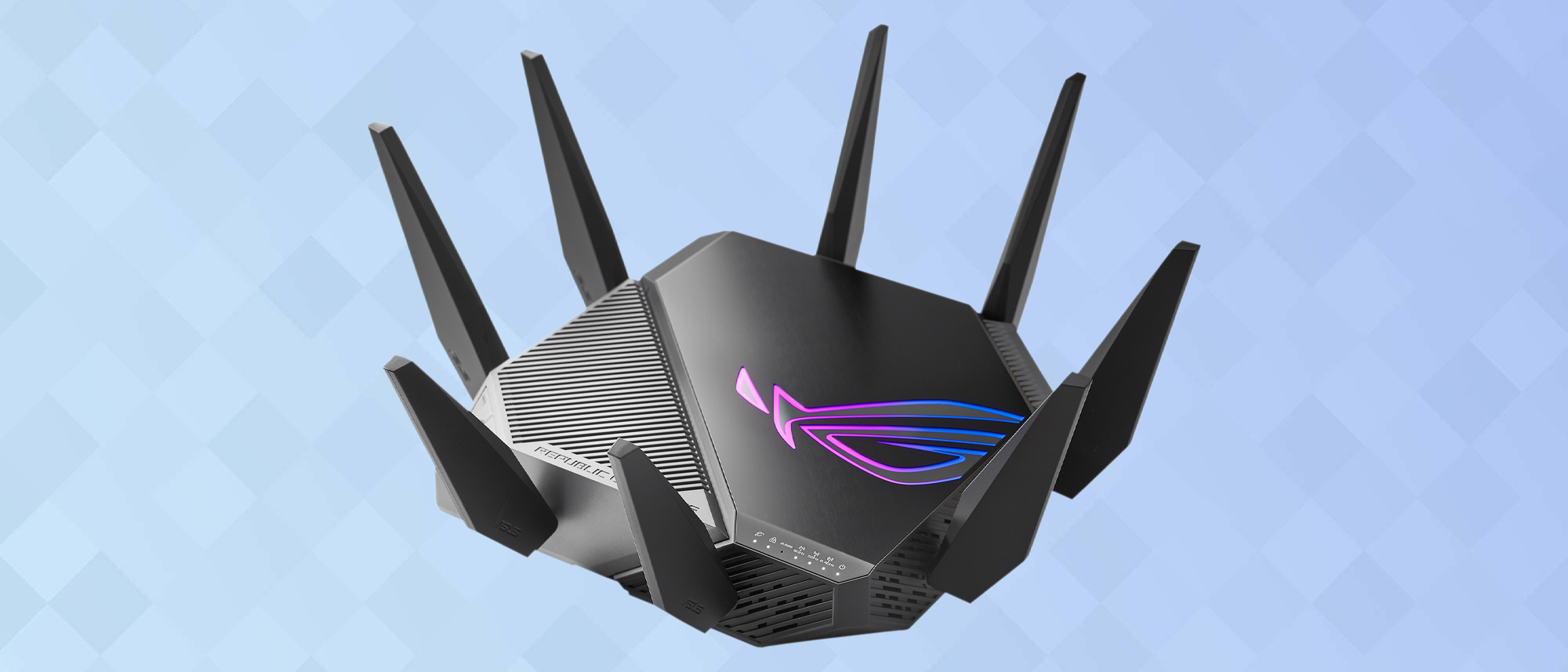Tom's Guide Verdict
The Asus ROG Rapture GT-AXE11000 is nothing short of the fastest and best engineered Wi-Fi router available today. It not only sets the record for the fastest data transfers but includes security, priority support and a gaming accelerator.
Pros
- +
Incredible throughput
- +
Excellent customization options
- +
Built-in security software
- +
Gaming accelerator
Cons
- -
Expensive
- -
Throughput falls off quickly with distance
- -
Requires 802.11AXE device to get top performance
Why you can trust Tom's Guide
Wi-Fi Spec: AXE11000
Number of Antennas/Removable: 8/No
Ports: 1 WAN/4 LAN gigabit per second, 2 USB 3.2
Processor/Memory/Storage: Quad-core 1.8GHz/1GB/512MB
Wi-Fi chip: Broadcom BCM4908
Peak 802.11ac performance: 2.96Gbps (at 15 feet)
Range: 85-feet
Size: 12.7 x 12.7 x 2.4 inches
Estimated Annual Electricity Cost: $16.70
Do you expect your router to be a speed demon capable of moving nearly 3Gbps? Well, at the moment, only one router can — the Asus ROB Rapture GT-AXE11000. This tri-band router can make data fly by pushing it over the 2.4-, 5- and 6GHz Wi-Fi bands via seven new high-performance 160MHz data channels. It also includes a slew of support to help gamers get that digital edge and has effective security software and priority support. It can even be set up in a mesh arrangement.
On the downside, GT-AXE11000’s throughput falls off quickly with distance, making it better to use in the same or an adjacent room. At the moment too, only a handful of the best gaming PCs are capable of getting the most out of this router.
Is it the best gaming router or the fastest general purpose, high-performance router available? Our ASUS ROG Rapture GT-AXE11000 review will show that the answer is yes to both, but the fact that it’s also less expensive than the Netgear Nighthawk RAXE500 makes it the closest thing to a high-output bargain.
Asus ROG Rapture GT-AXE11000 review: Pricing and availability
While it has a list price of $550, the Asus ROG Rapture GT-AXE11000 can be found online for as little as $450. That’s still a lot, particularly compared to the current batch of mid-range routers, but represents one-quarter off the price of the Netgear Nighthawk RAXE500.
Too much for a small black box with antennas? The router’s older cousin, the ROG Rapture GT-AX1100 lists for $450 but can be had for $380. The high-performance tri-band router lacks the GT-AXE11000’s extra 6GHz data band though.
Asus ROG Rapture GT-AXE11000 review: Design
Like a piece of modern sculpture, the ROG Rapture AXE11000 is all black and shaped like a square with its corners cut off. Sure to be a conversation starter at your next gaming party, it looks more aggressive than the bat-wing shaped Nighthawk RAXE500 and it would be a shame to hide it in a closet or basement next to your modem. The Asus Republic of Gamers logo is lit up in LEDs on top, and can be rendered in 10 different colorful effects, any of which might drive your cat crazy.
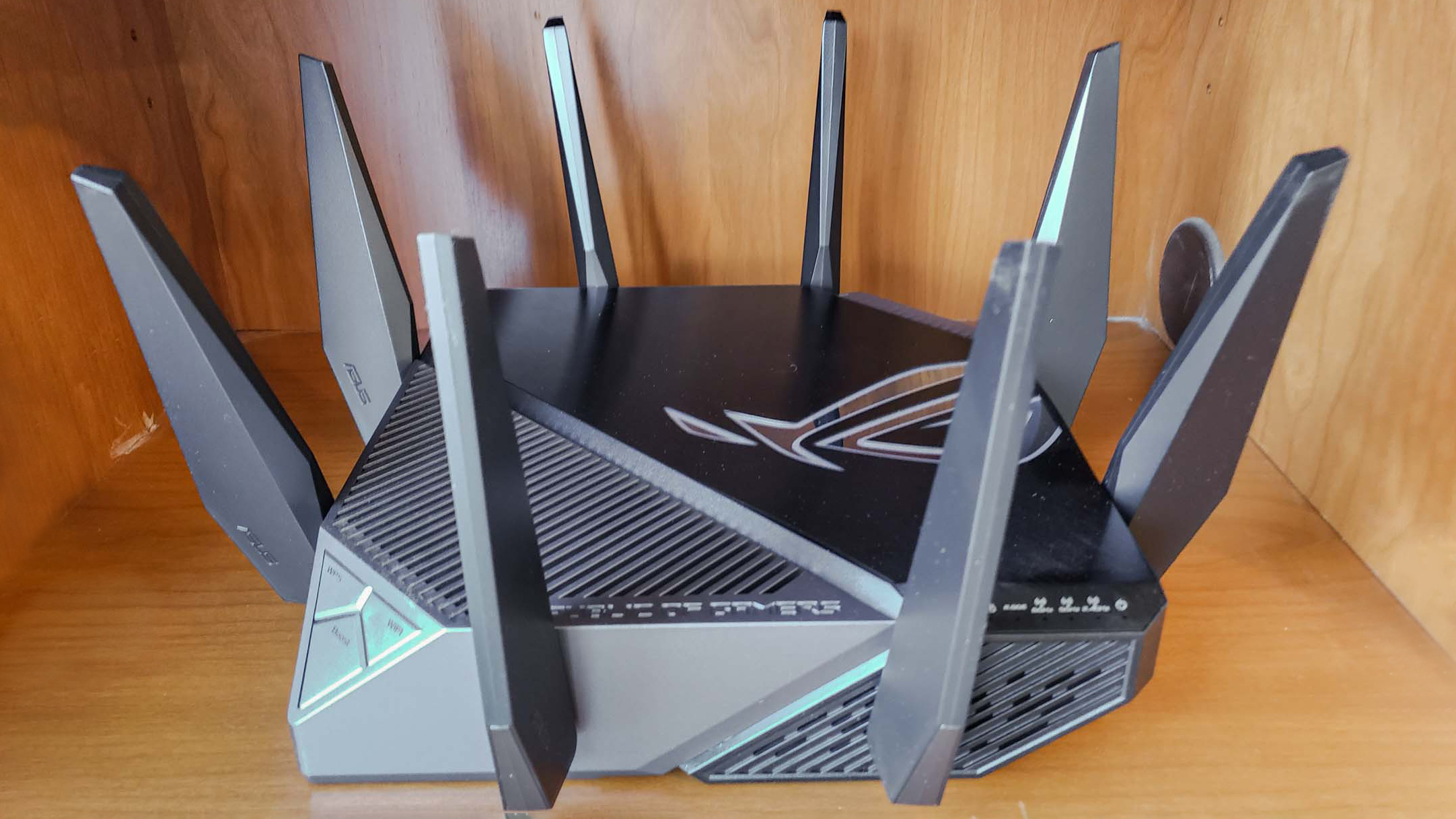
Additional white status LEDs show what’s going on inside: Besides a light for Power, the router shows internet activity and wired connections as well as the 2.5Gbps input port. There are also lights for transmissions on the 2.4, 5 and 6GHz networks.
The Asus Republic of Gamers logo is lit up in LEDs on top, and can be rendered in 10 different colorful effects, any of which might drive your cat crazy.
At 12.7 x 12.7 x 2.4 inches, it’s half the size of the RAXE500 and has eight individual antennas that can’t be removed but can swivel and fold out to capture the strongest signal. They add an extra 4.8-inches to the height of the router when extended. Inside, there’s a 6GHz amplifier to help capture the cleanest, strongest signal possible.
There are vents all around to help cool the device and it never broke 98 degrees Fahrenheit, even during gaming and heavy data lifting.
A trio of keys lets you boost the router’s performance, turn off the wireless radio or initiate the Wi-Fi Protected Setup process.
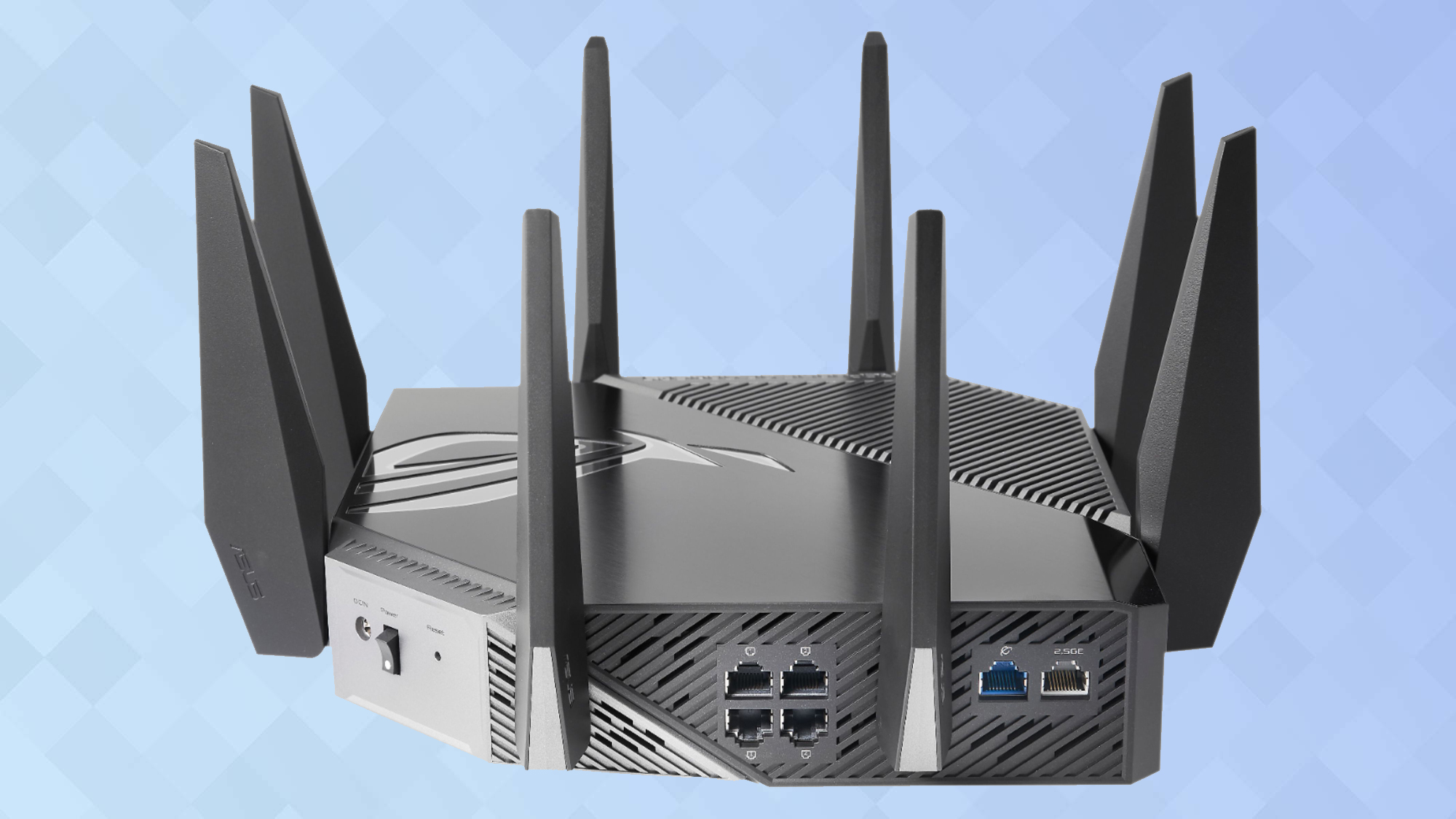
Rather than a single port panel in the back, the ROG Rapture GT-AXE11000 has three spread out on the router’s periphery. In addition to one for the power, there’s a place to plug in the gigabit per second WAN input as well as one for the 2.5Gbps input that doubles as a dedicated wired gaming port. There are also four downstream Ethernet ports. The third panel has room for two USB 3.2 devices, like external drives.
Asus ROG Rapture GT-AXE11000 review: Wi-Fi capabilities
The ROG Rapture GT-AXE11000 offers a sea of new spectrum by adding seven new ultra-wide 160MHz channels in the 6GHz band, which can push nearly 5Gbps of extra throughput. Powered by a Broadcom BCM4908 chip, the router has a 1.8GHz processor, 1GB of RAM and 512MB of flash storage for settings and firmware.
To say that the GT-AXE11000 has a lot for dedicated gamers is an understatement.
In essence, the GT-AXE11000 is a 4X4 tri-band router that can handle 12 individual streams of data at once. It uses the latest MU-MIMO techniques as well as beamforming and the 1024QAM protocol to squeeze every bit of data into the air. It tops out at 1.148Gbps for 2.4GHz transmissions along with 4.804Gbps for both the 5GHz and 6GHz bands. That adds up to a peak throughput of 10.8Gbps, matching — at least on paper — the Nighthawk RAXE500.
To say that the GT-AXE11000 has a lot for dedicated gamers is an understatement. In addition to a low-latency design, the router has Asus’s own Game Boost accelerator that prioritizes gaming systems by giving the wired gaming port an express lane onto the Internet. Once online, it is sped up thanks to a connection with the Outfox gaming network (a three-month subscription to Outfox is included).
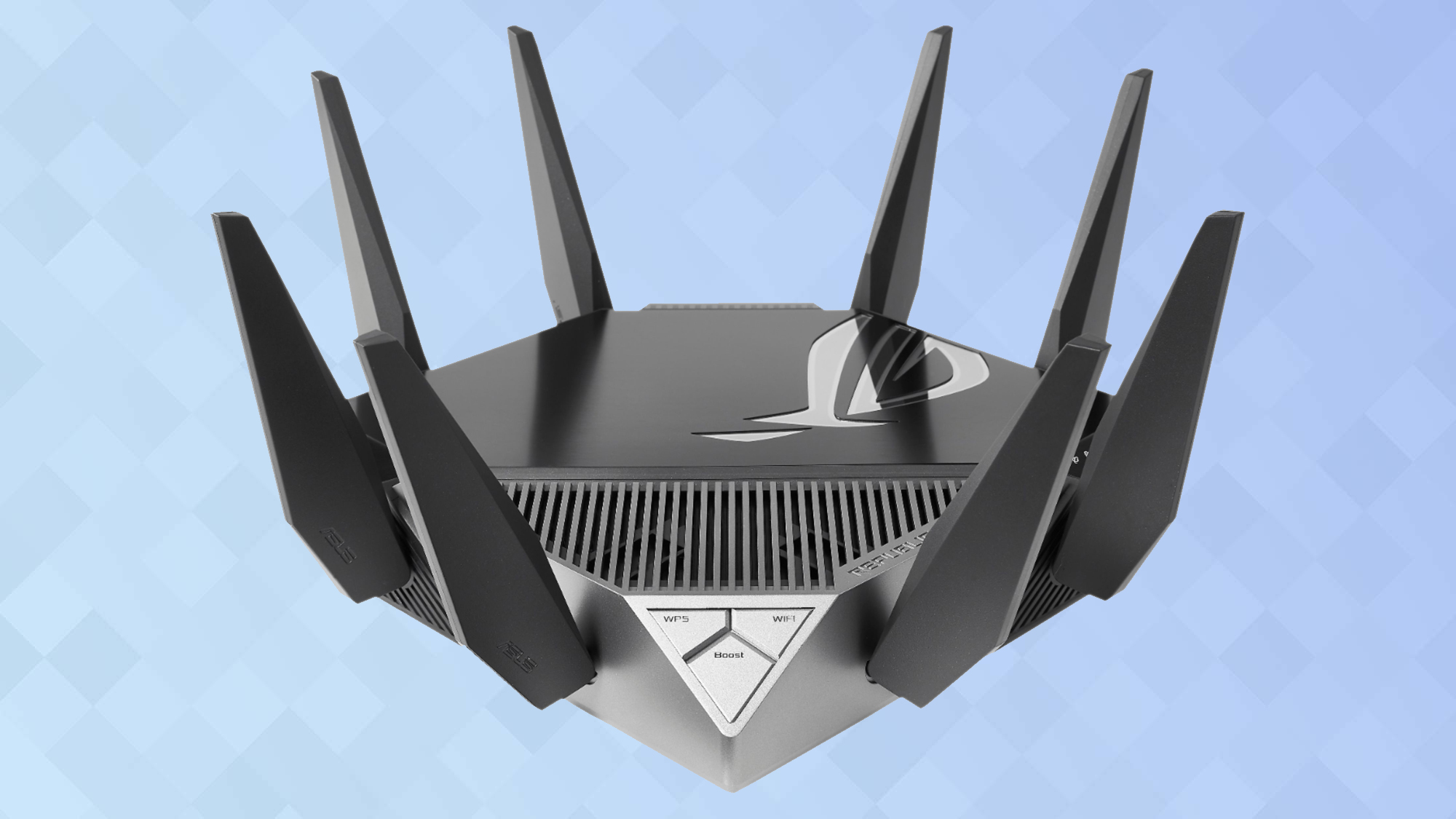
Sure, it’s fast, but the GT-AXE11000 is among the most secure routers available. It comes with the Asus AiProtection software that uses Trend Micro’s antivirus program to detect and stop malware, new and old. Unlike Netgear’s Armor security software, AiProtection doesn’t require any client app. The router also includes parental controls that can keep the worst of the web away from as many as 16 children by filtering content based on age as well as limiting screen time.
Asus ROG Rapture GT-AXE11000 review: Performance
The Asus ROG Rapture GT-AXE11000 is nothing short of the fastest router we’ve seen, with the ability to get tantalizingly close to the 3Gbps barrier. Based on a series of tests using Ixia’s ixChariot network benchmark with 10 simulated data hungry users, the GT-AXE11000 showed itself to be the current top gaming dog. To get the most out of it, you’ll need one of the few devices that can work with 6GHz data; to test the router, I used the Samsung Galaxy S21 and the Samsung GalaxyBook Pro, both of which have Wi-Fi 6e.
| Throughput (combined) | Asus ROG Rapture GT-AXE11000 | Netgear Nighthawk RAXE500 | Linksys Hydra Pro 6E |
| 15 feet | 2.956Gbps | 2.396Gbps | 1.958Gbps |
| 50 feet | 267.9Mbps | 215.8Mbps | 120.4 |
| 75 feet | 98.3 | 148.6Mbps | 37.0Mbps |
Its best showing was at 15 feet, where the router was able to move 1.47Gbps over the 6GHz band, while delivering 1.37Gbps over the 5GHz band and 116.3Mbps using its 2.4GHz band. That adds up to a total of 2.956Gbps – 18 percent more data than the Nighthawk RAXE500’s 2.396Gbps. It’s also 33 percent more than the Linksys Hydra Pro 6E (at 1.958Gbps) and about three times the performance potential of an 802.11AX (Wi-Fi 6) device. The GT-AXE11000 is clearly the router to get if you have the need for speed.
At a distance of 50 feet, the GT-AXE11000 managed to send a combined throughput of 267.9Mbps, outpacing the Nighthawk RAXE500’s 215.8Mbps. At this point, older AX-based routers took the lead, with the TP-Link Archer AX6000 delivering 396.4Mbps and the Linksys MR9600 moving 363.3Mbps.
With the distance increased to 75 feet, the GT-AXE11000’s 98.3Mbps of delivered bandwidth was second best compared to the Nighthawk RAXE500’s 148.6Mbps. Still, the AX router crowd stayed in front with the Asus AC-RT86U leading at 250.1Mbps. The GT-AXE11000 had a range of 85 feet, well behind the RAXE500’s 105-foot range.
It was quite good at distributing Wi-Fi through my home. When the test system was placed in a room 25 feet away and separated by a wall, the GT-AXE11000 still was able to deliver 1.07 Gbps of throughput, plenty for an impromptu gaming session. Still, it was slightly behind the Nighthawk RAXE500’s 1.14Gbps of bandwidth. By contrast, the TP-Link Archer AX6000 and Asus RT86U supplied 738.0Mbps and 698.5Mbps – about one-third less throughput.
When it came to sending a Wi-Fi signal through a ceiling to a second floor bedroom, the GT-AXE11000’s 343.2Mbps fell short of the RAXE500’s 851.0Mbps. Even the AX-based routers did better with the TP-Link Archer AX6000 or the Netgear AX8 at 671.4Mbps and 629.5Mbps.
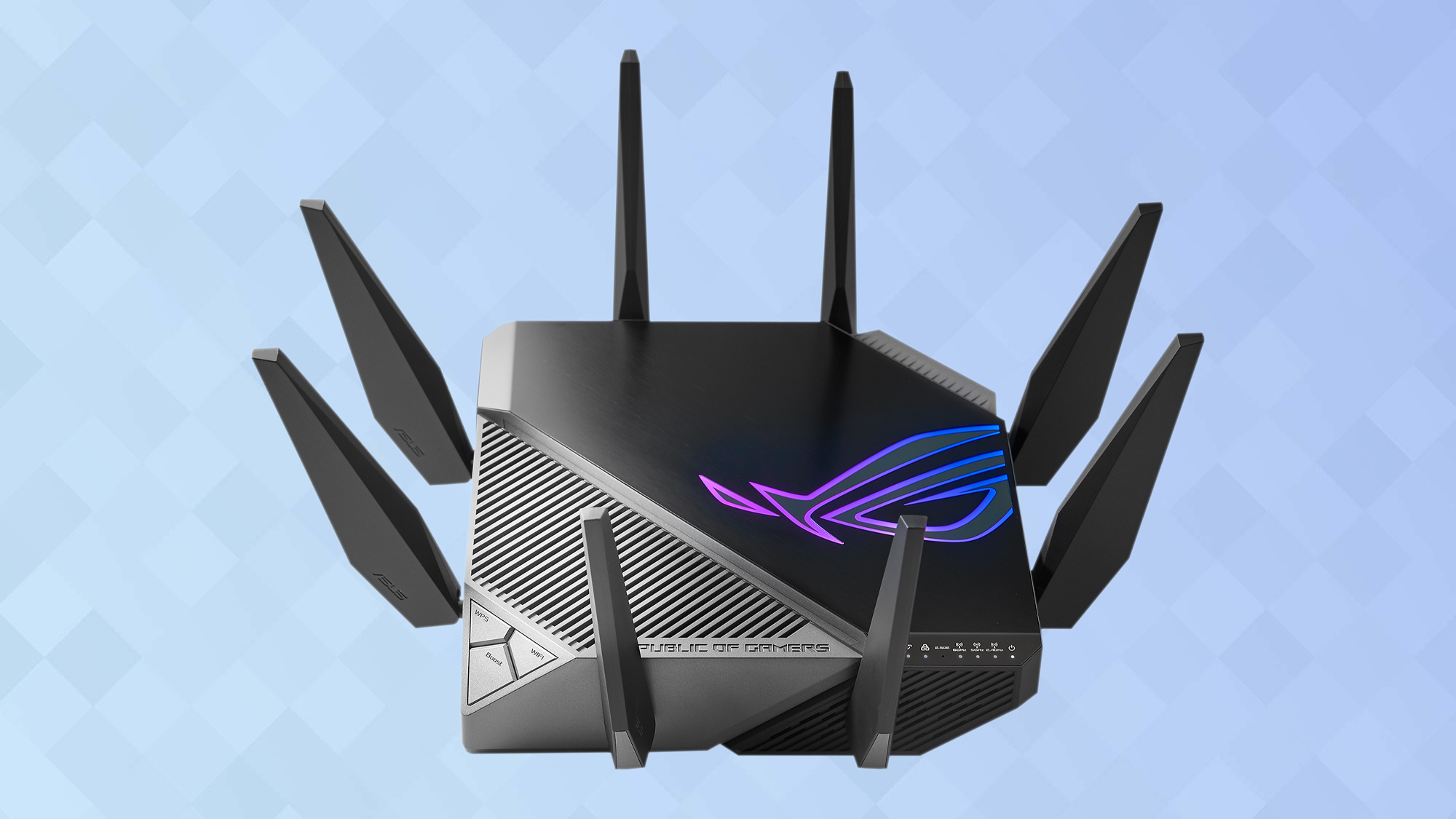
Even though it excels on the gaming front with excellent response time, the GT-AXE11000 was a dependable, traditional home router. I used it for watching 4K videos and downloading large files. It passed the informal saturation test where I played videos on a MacBook and listened to Internet radio with a Samsung Galaxy S6 tablet as an iPhone tapped into the Spotify music database and a ThinkPad T470 moved files onto and off a RAID server. All the audio and video came through cleanly.
The GT-AXE11000 never used more than 13.6 watts of power which is less than the RAXE500’s 15.4 watts, but the Netgear router has a sleep mode that lowers its power consumption to 5.4 watts; the GT-AXE11000 doesn’t have this money-saving feature. Still, it would cost an estimated $16.70 to use the GT-AXE11000 24/7 if you pay the national average of 14 cents per kilowatt hour of electricity. By contrast, the Nighthawk RAXE500 should cost an estimated $11.30 with the same pricing and usage.
Asus ROG Rapture GT-AXE11000 review: Configuration options
As powerful as it is, the GT-AXE11000 is also one of the most customizable routers on the market. While the app has plenty of options, using a connected browser provides more choices. Both are visually oriented but – be warned – both are dark and look sinister.
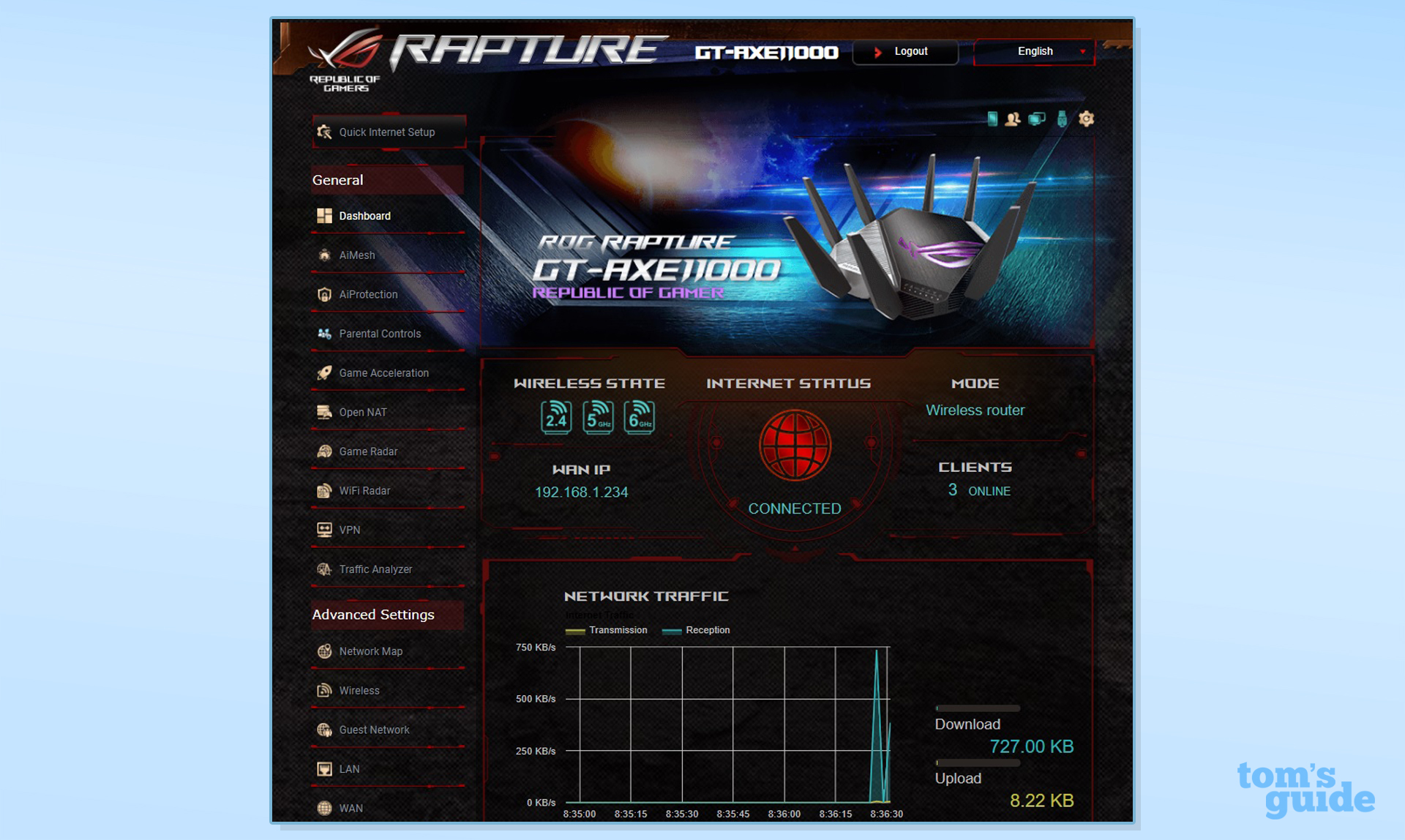
The Dashboard itself is a marvel of integration, although its contents don’t fit on an HD screen. Down the center are six zones that show what’s going on inside the router, from the Wireless State, IP address and number of clients at the top to Network Traffic below to possible gaming routers in a geofencing map. You can even take control of the LED lighting. Unfortunately, it took zooming out in a browser to take it all in, although it made some of the type too small to read without squinting.
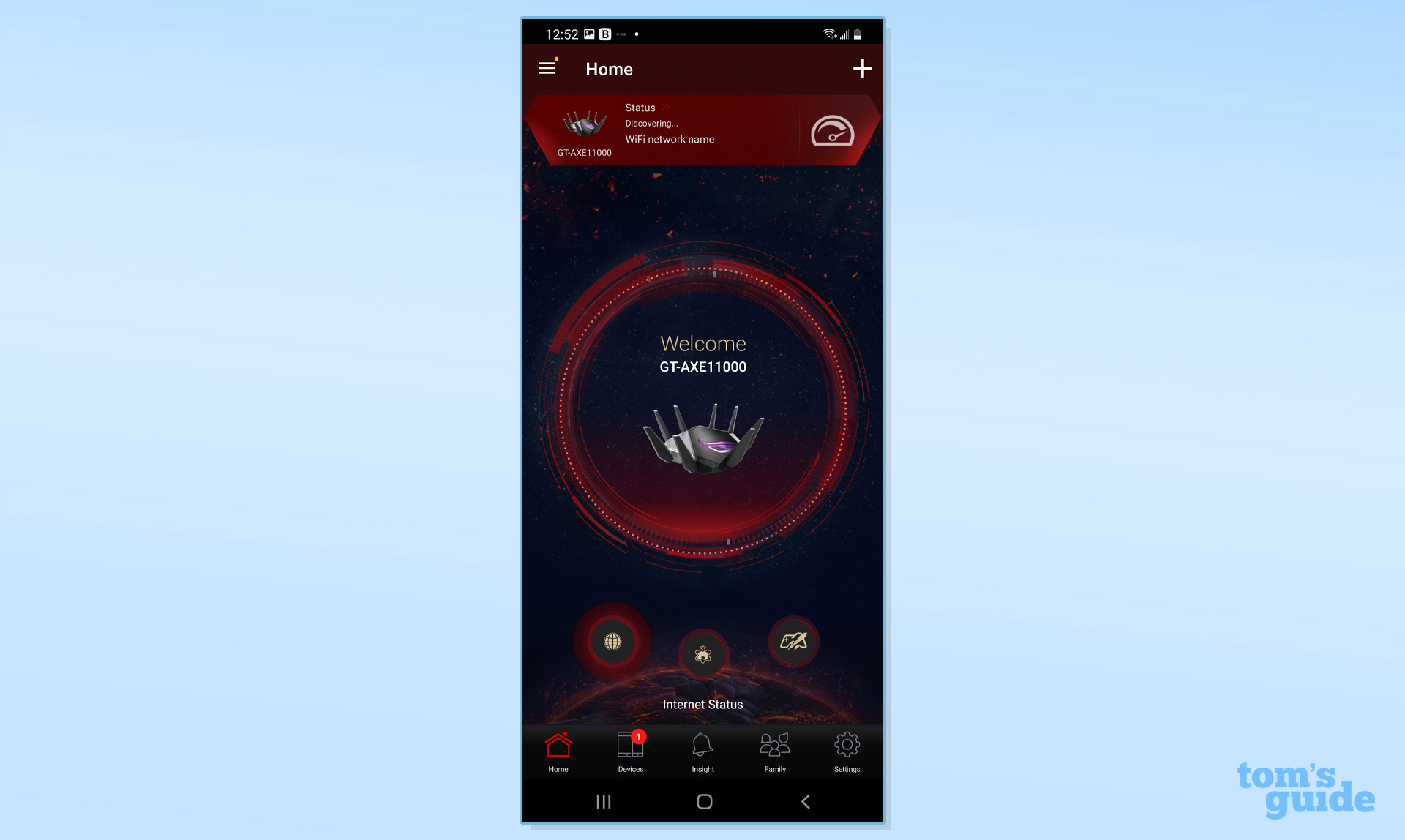
Along the left are options to change the wireless network settings, use the router in an Asus AiMesh topology, set up the Parental Controls and connect using a VPN.
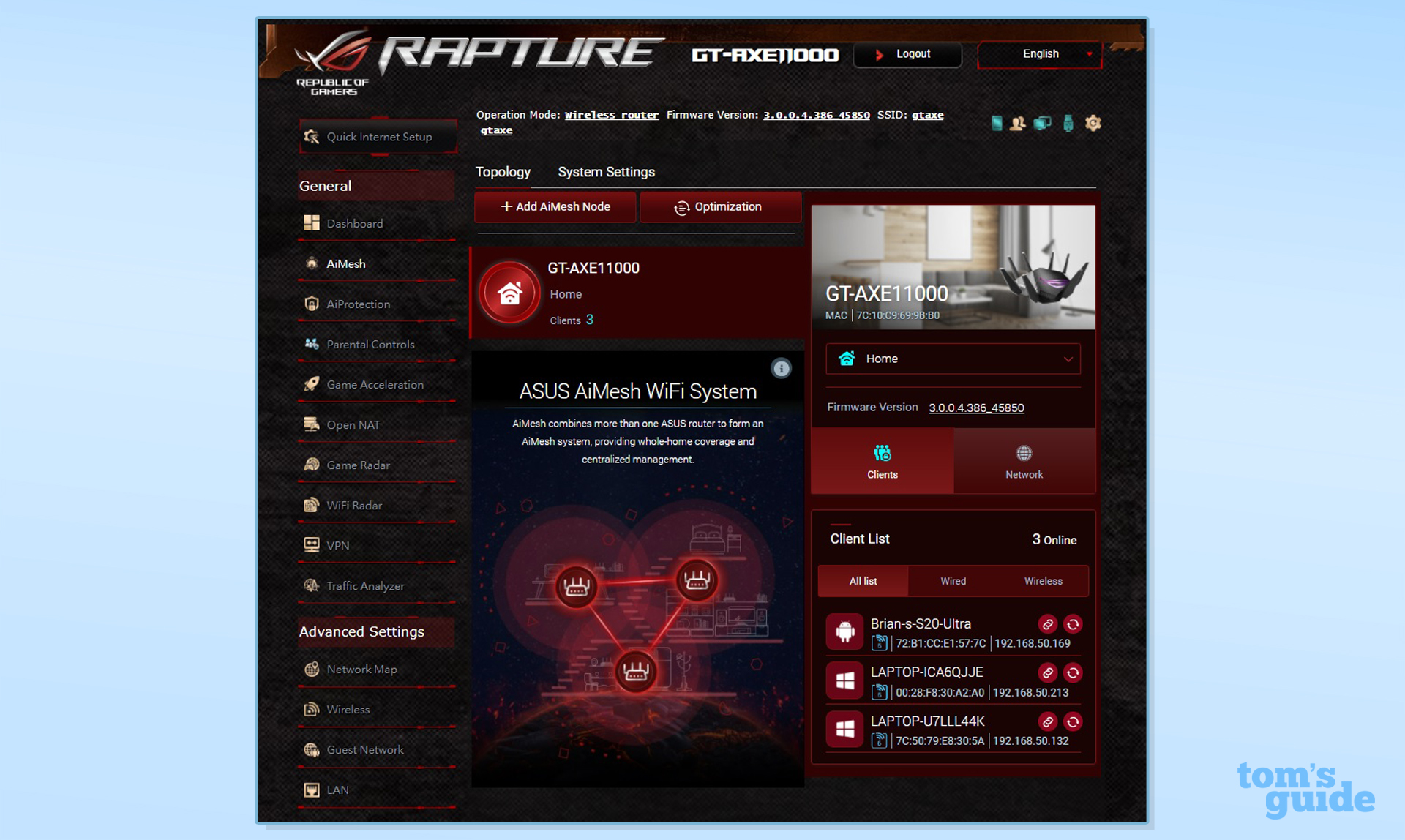
About halfway down are the powerful Advanced Settings. Here you can see a network map of connected clients, Wireless Network, LAN, WAN and a place to configure the Guest network. Inside are a multitude of ways to tweak the networks, including things like picking whether you want to use 20-, 40-, 80- or 160MHz data channels.
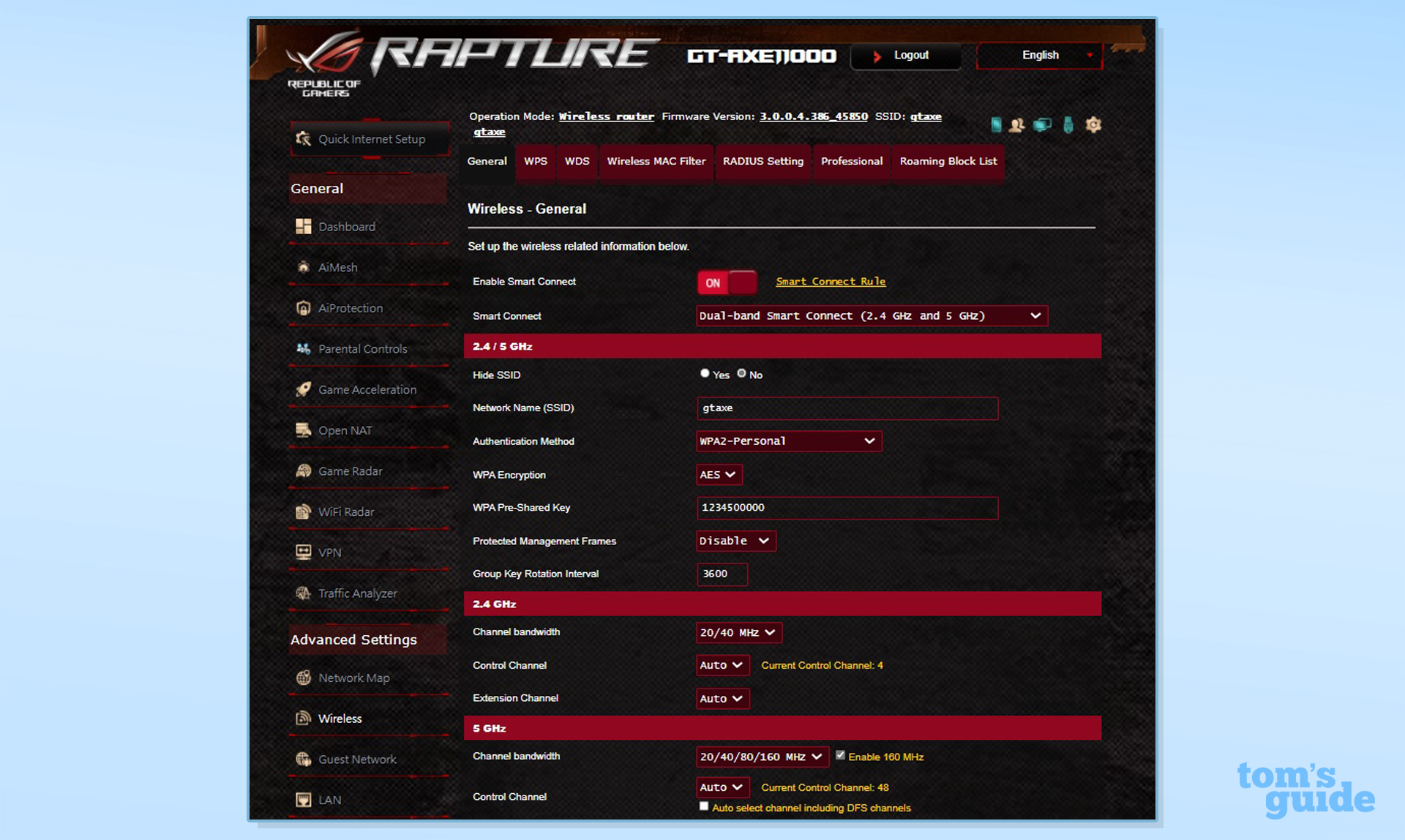
Don’t miss the Professional tab at the top. It has a bunch of optimization settings, including the RTS Threshold, DTIM and Beacon Intervals. It does lack the ability to adjust the Fragmentation Length, something the Nighthawk RAXE500 allows.
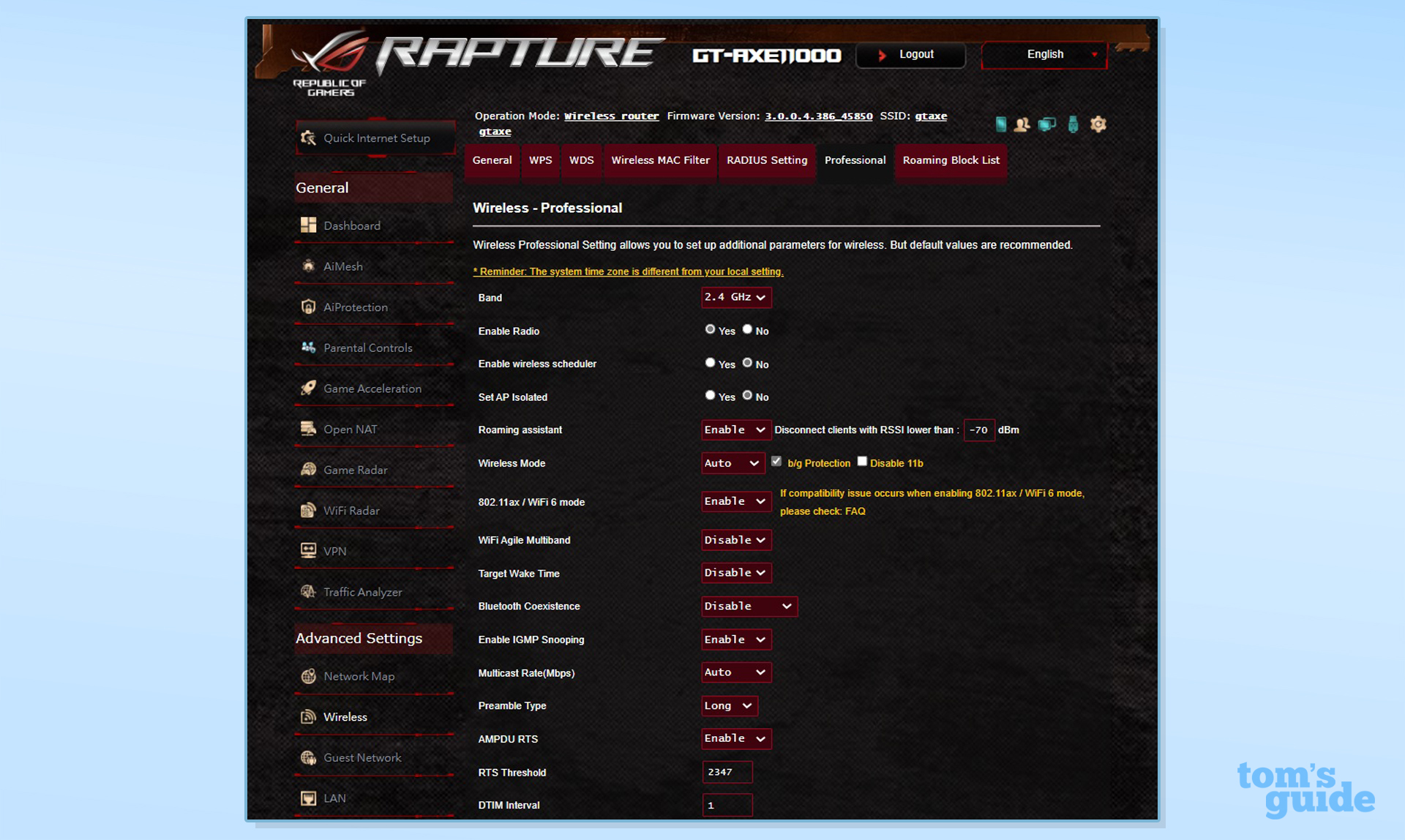
The AiProtection security software is a big bonus. As opposed to Netgear’s Armor, it works exclusively at the router level to block dangerous malware. No software needs to be loaded and it doesn’t cost extra. For Armor to fully protect, devices need to load the included Bitdefender software and after the introductory period, it costs $100 per year.
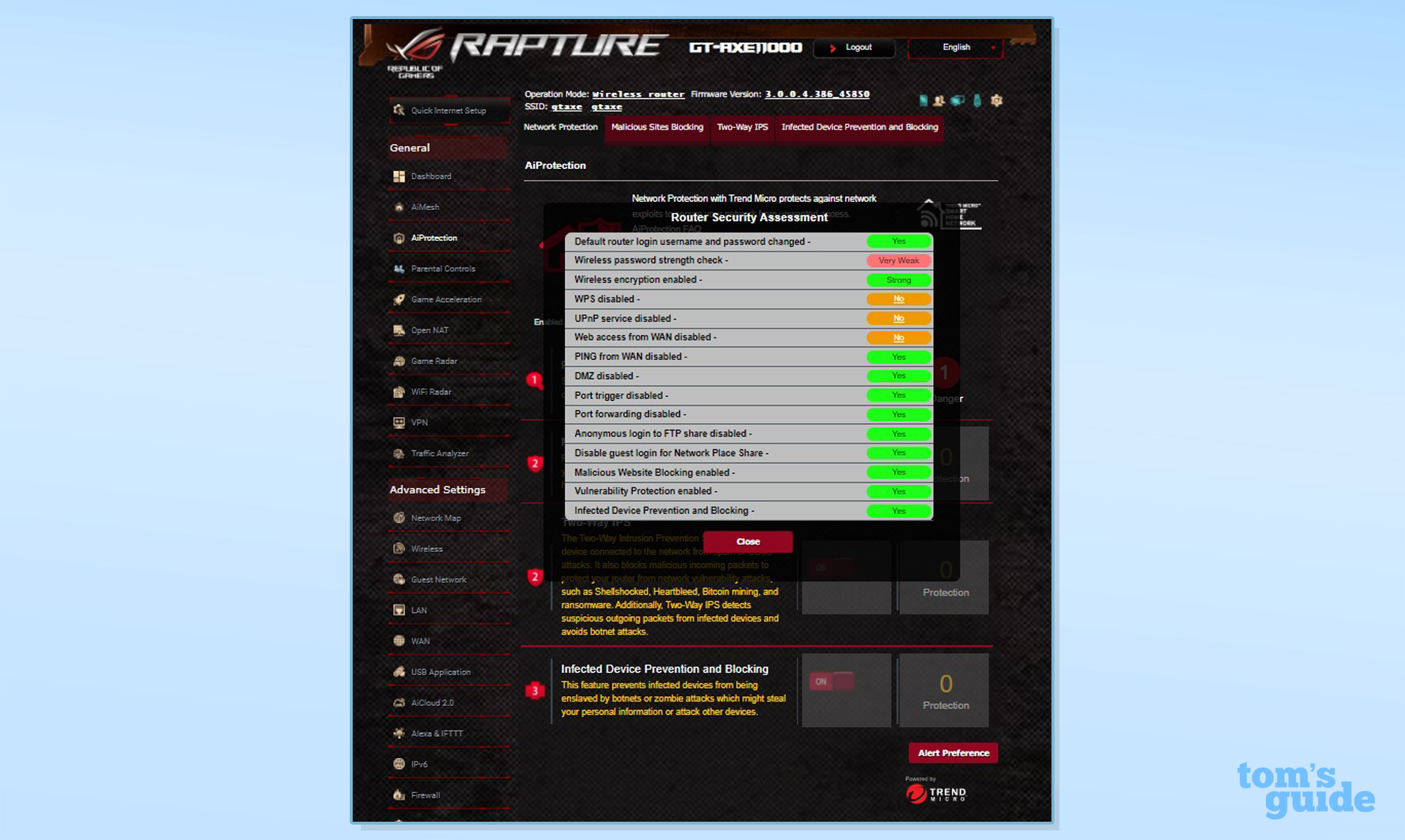
Asus includes VIP support with the GT-AXE11000 router that lasts for two years, twice as long as the year of coverage for the Nighthawk RAXE500. More to the point, it includes lifetime priority response from the company’s technicians; Netgear only includes 90-days of support.
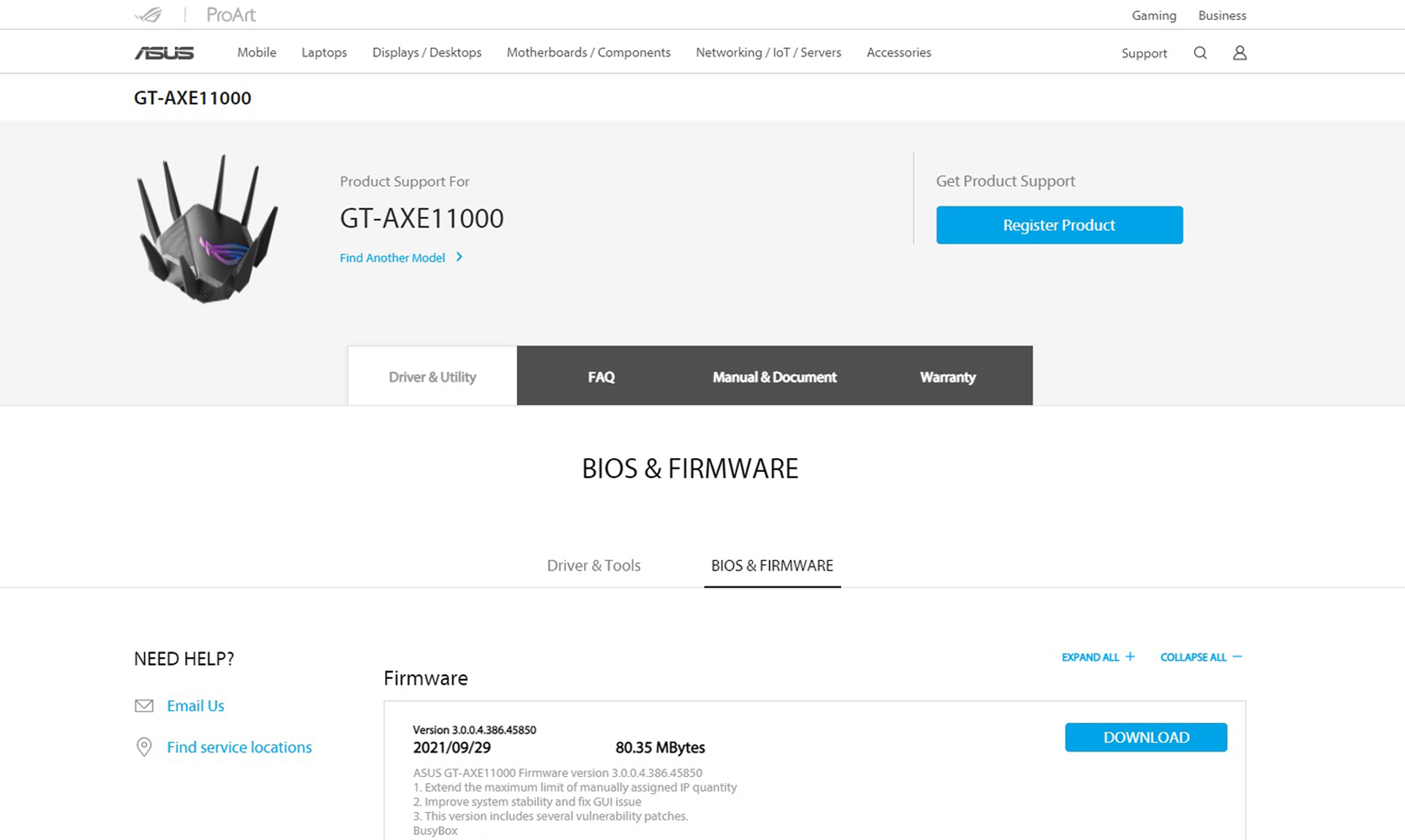
The support site has a slew of self-serve items, like directions for doing just about anything with the GT-AXE11000, helpful FAQs and downloads for the latest software. It has an incredibly comprehensive 180-page manual that should be printed and kept next to the router.
Asus ROG Rapture GT-AXE11000 review: Verdict
By combining data flow over the 2.4-, 5- and 6GHz channels, the Asus ROG Rapture GT-AXE11000 sets a new standard for throughput. Its range might be limited but the GT-AXE11000 is an excellent way to distribute a lot of data to nearby devices.
The router is one of the most customizable available and it can be set up exactly the way you want it. It also allows installation and configuration via some of the best mobile apps around or with a connected browser. In addition to gamer-friendly software for speeding up your data packets online, all of the basic parameters — and a few esoteric ones — can be easily adjusted.
At $450, it costs 50 percent more than lower-performing AX-based routers, like the TP-Link Archer AX6000 or the Linskys Max Stream MR9600. It is, however, less expensive than the $600 Netgear Nighthawk RAXE500. In other words, the GT-AXE11000 is a router that gives you buckets of data at a reasonable price.
Brian Nadel is a freelance writer and editor who specializes in technology reporting and reviewing. He works out of the suburban New York City area and has covered topics from nuclear power plants and Wi-Fi routers to cars and tablets. The former editor-in-chief of Mobile Computing and Communications, Nadel is the recipient of the TransPacific Writing Award.
